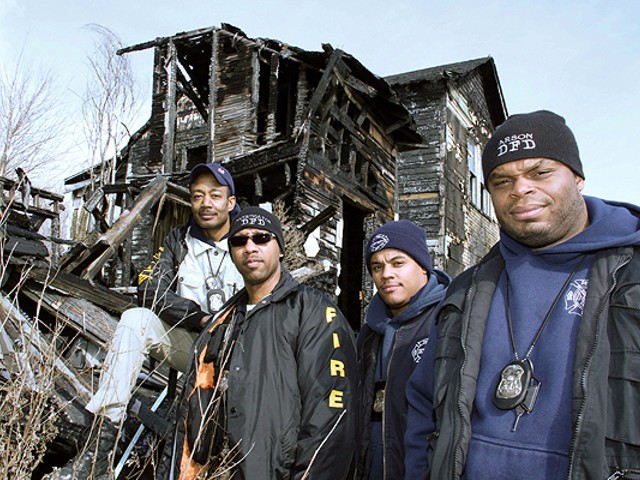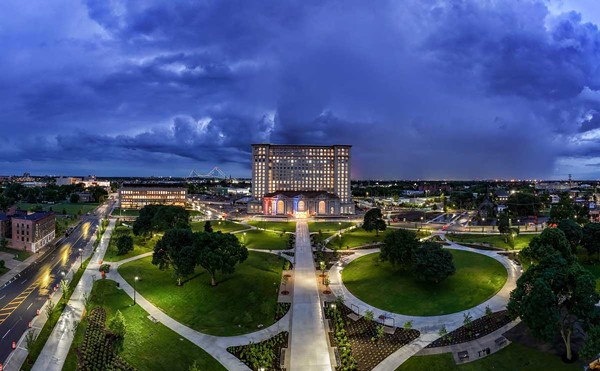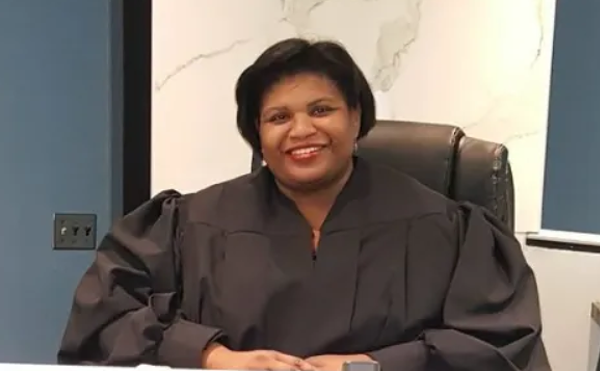Perhaps no other city in the world has the relationship with fire that Detroit does. If you could create a time-lapse image of the city's 313-year history, you would see a city building itself up and burning itself down, over and over again. That said, the fire is not always the destructive, city-destroying inferno; sometimes it is tamed to a purpose. But it is engrained in the city's history and culture so deeply that it's sometimes hard for a local to see all the places it hides.
Of course, the big conflagration began on June 11, 1805, when the city of approximately 600 residents burned almost completely to the ground. That's how Detroit got its prescient motto: "Speramus Meliora; Resurget Cineribus," Latin for "We Hope for Better Things; It Shall Rise From the Ashes." Pictured on the city's flag are both the burning city and the future dream city Detroiters hope for. Is there another city in the world, in all of history, whose very seal shows the city in flames?
If fire visited Detroit more frequently than other cities, it has to do with the way Detroit was built up in the 19th century by the billions of board-feet that came from the clearcutting of the state. All that wood would prove fuel for the spectacular fires of the turn of the last century: the Detroit Opera House fire of 1897, resulting from an explosion that blew out the back of the building and engulfed much of the block; or the burning of the bridge to Belle Isle in 1915, caused when a few hot coals fell off a workman's vehicle. In the later years of the 19th century, during hot weather, even the streets of Detroit could catch fire, oozing flammable pitch and resin, and bombarded with discarded cigar ends.
Then there are the fires of Detroit's foundries, furnaces, and refineries, a consequence of the city's location between the iron ore mines to the north and the coal fields to the south. Twice in the last century, the Arsenal of Democracy was called upon to build machines of war, both the bombs to burst and the vehicles to get them on target. At the height of World War II, the steel mills running full tilt would glow brightly at night, casting what one writer called "a kind of hellish glimmer over everything." Even a generation ago, the motorist driving into the city would first see the Stygian towers of the refineries along the Rouge River blasting flames into the air, looking something like the opening scene of Blade Runner.
Then there's the fire harnessed by the city's main contribution to the world: the automobile. During boom times in the 20th century, the city teemed with chariots created in foundries and literally powered by fire. Every day, billions of controlled explosions propel Detroiters down the city's roads and freeways. The force driving this machine city is the same protean power of myth, the fire Prometheus stole from the gods and gave to man.
That Promethean symbolism is branded into the city's art, in the blast furnaces of Diego Rivera's Detroit Industry murals, the rockets streaming up behind the central figure in the mural "Man's Mobility" in the main library's Adam Strohm Hall, even in the city's postwar "Spirit of Detroit," the figure holds a glowing orb in his hand, officially signifying something spiritual, but nonetheless casting a glow much like a burning star. Detroiters' lives are powered by fire, a force that can spin terrifyingly out of control.
Fires accompanied the city's most historic moments of unrest. For a generation of Detroiters, it was a mark of shame that so many buildings burned in 1967's 12th Street Riot. But those who loudly blamed inner-city residents for "burning down their own city" often only spoke in whispers of 1943, when white rioters overturned the cars of black motorists and set them on fire. They may not even realize at all that, in March of 1863, white rioters burned down 35 homes in the city's small black quarter. Or fires used to intimidate minorities, as when, on Christmas Eve in 1924, a crowd of thousands gathered to watch an oil-soaked 6-foot-tall cross burn on the steps of Detroit's county building. Fueled by race hatred, Detroit's fires were burning long before the smoke clouds of 1967.
In the 1980s, with vacancies rising, all that fuel began to burn. An orange glow in the night sky often meant another house going up in flames. That was when Detroit's Devil's Night became synonymous with "recreational arson," a night when the overtaxed fire department couldn't handle the blazes set for a variety of reasons, including revenge, amusement, insurance fraud, or even ridding a neighborhood of an unwanted trap house. In one night in 1984, more than 800 fires blazed in the city on Oct. 30, setting a new record.
Fire appears in our music, in its lyrics, its titles. Detroit's Electric Six weren't the first to reference it. Detroiters embraced "The Roof Is on Fire" by Rock Master Scott & the Dynamic Three, and even before that, Detroit's adopted son John Lee Hooker wailed in vain:
Oh, the Motor City's burnin'
It ain't no thing in the world that I can do.
Don't ya know,
Don't ya know the big D is burnin'?
Ain't no thing in the world that Johnny can do.
My hometown burnin' down to the ground
Worser than Vietnam.
That said, fire has a reputation for cleansing, for purging, and good things can come in its wake. The Great Fire of 1805 cleared the way for downtown's fanciful street plans, with circular plazas and hexagonal blocks inspired by Pierre L'Enfant's plan for Washington, D.C. The ugly arson of 1863's race riot prompted the city to create its first police force. The fire of 1943's riot set in motion the commemorative march to the river 20 years later, where Dr. Martin Luther King Jr. first gave his "I have a dream" speech in our fair city.
It all goes back to Detroit's phoenix-like symbolism. From the ashes of the past, Detroit is a city always leaning into the next moment, impatient to tame the fires that run wild and use them to forge our future. We are, we remain, hoping ... for better things.





